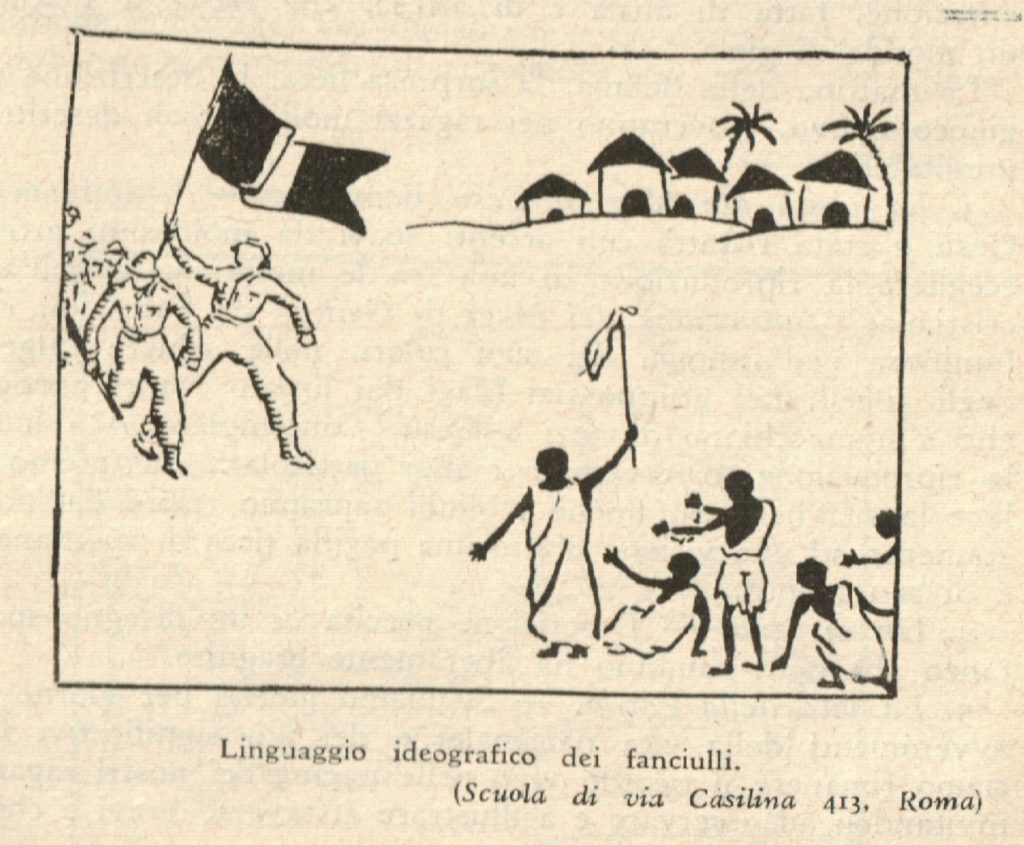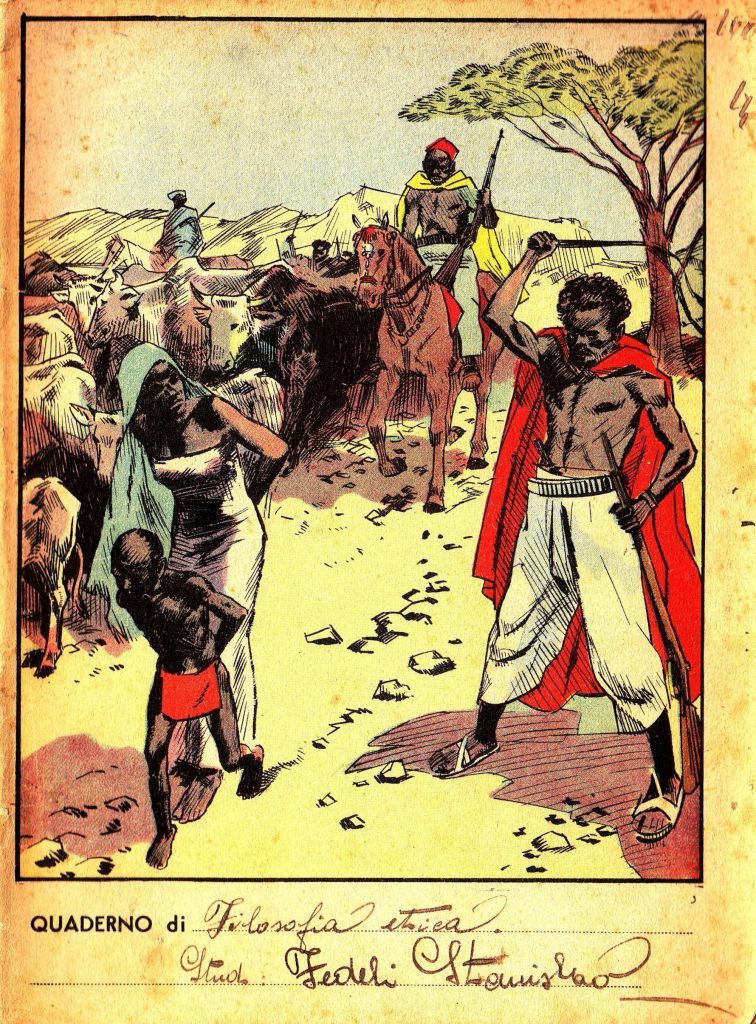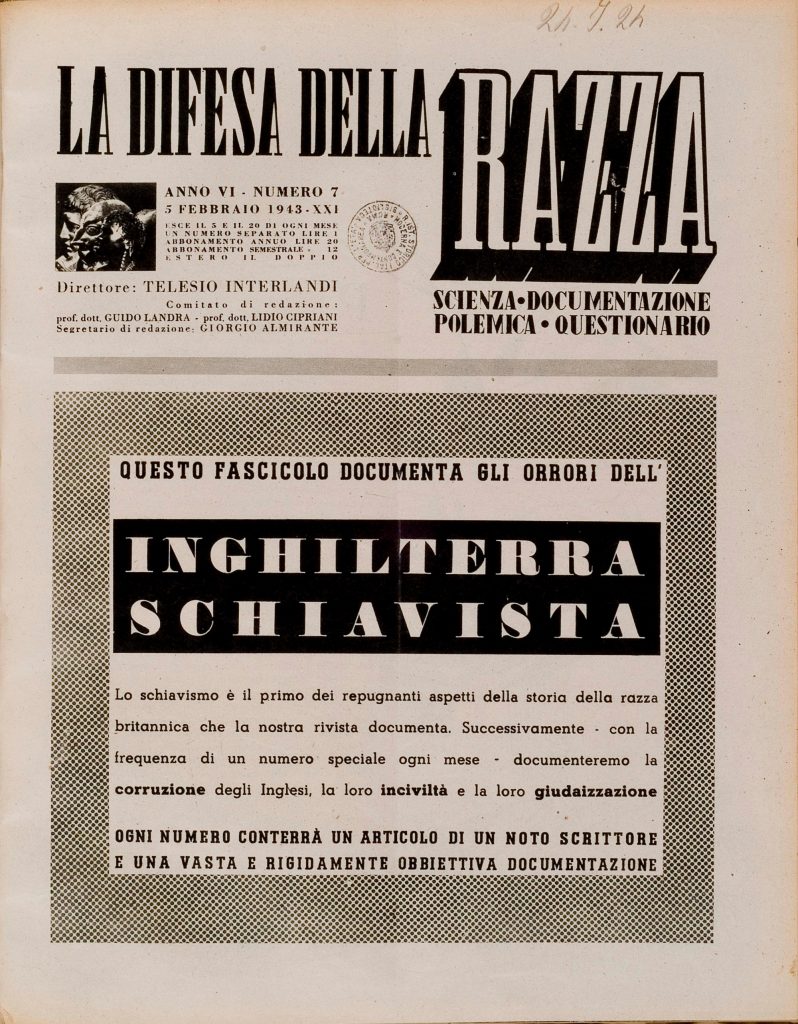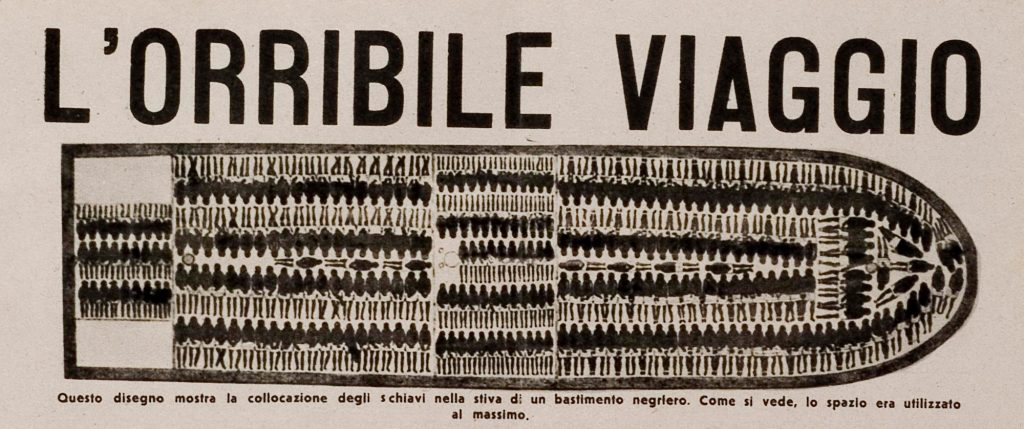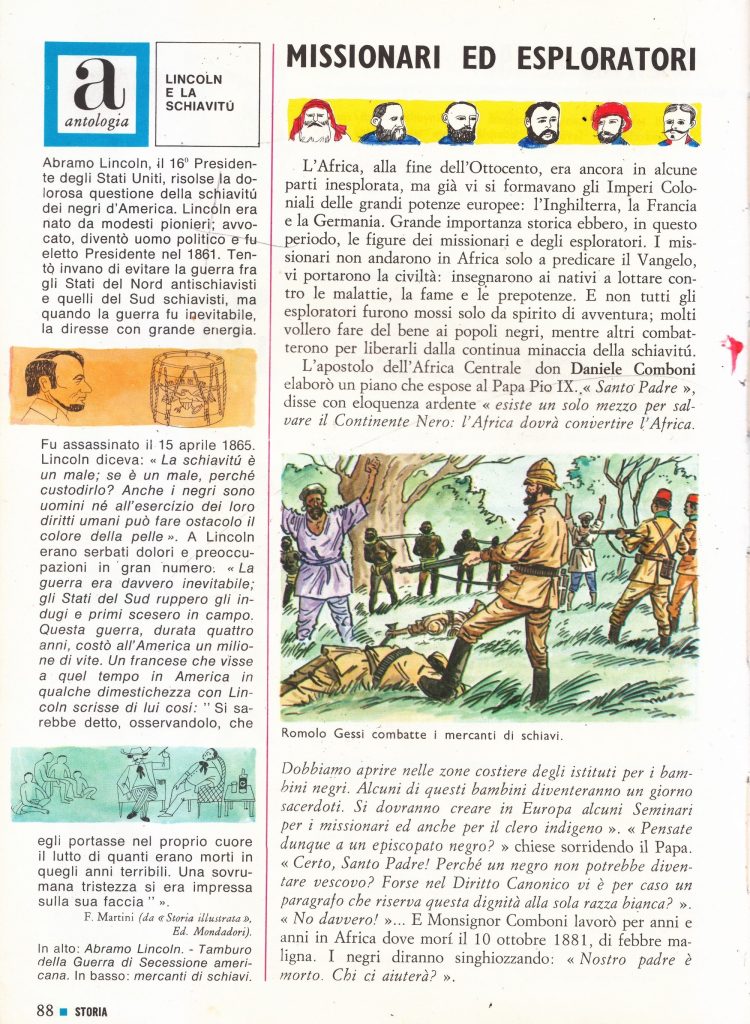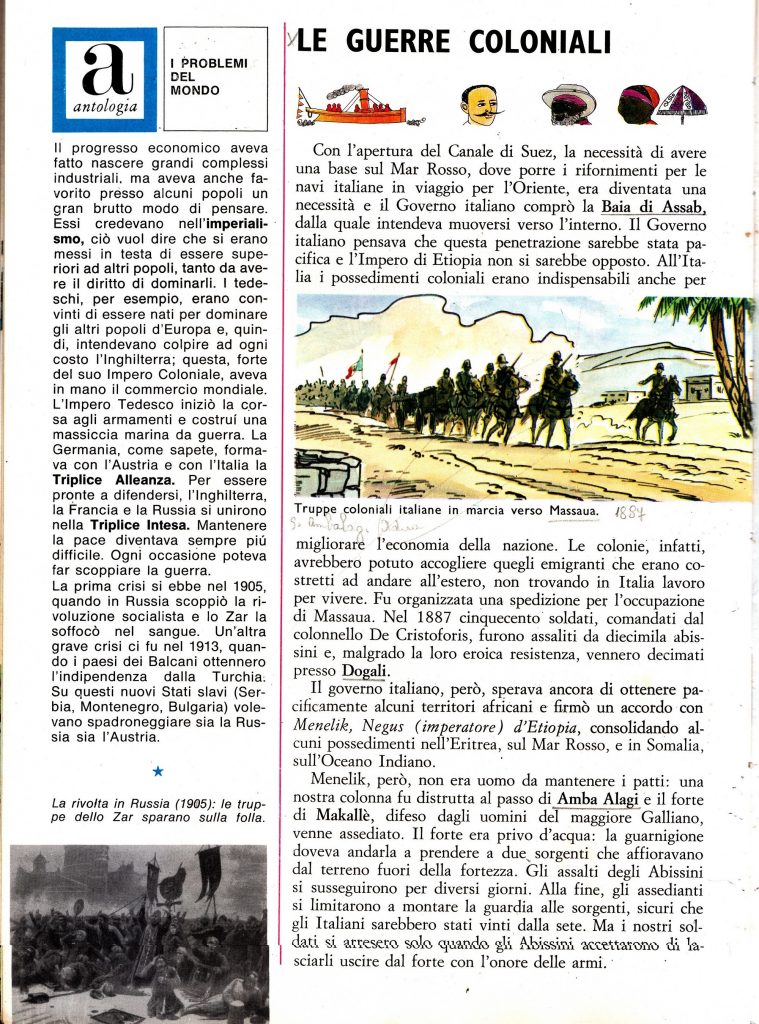A THEME VIRTUALLY ABSENT IN THE 19TH CENTURY
In the Liberal Era, the subject of the Atlantic slave trade rarely entered the Italian school textbooks. The focal point of the history taught between the 19th and 20th centuries was in fact the Nation: its illustrious Roman antecedents, the preludes to national unity, the Risorgimento.
It is therefore interesting to find the mention of American slavery in a math problem, a textbook from the 1880s which probably republished an already edited text (before the Civil War?); here the apparently neutral accounting reduced the slave labour on the American plantation to the maintenance costs from a slave owner’s point of view.
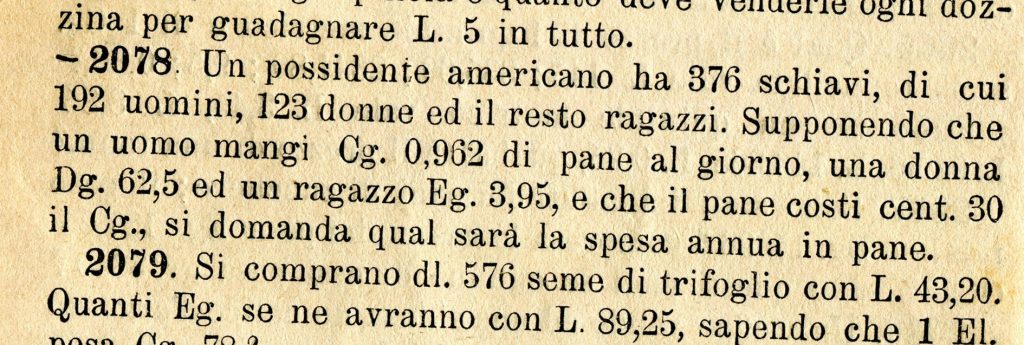
FASCIST IMPERIALISM AGAINST SLAVERY?
In the Fascist era, when Italy occupied Ethiopia, the subject of slavery in the Horn of Africa came to the fore.
In fact, the Fascist regime, looking for arguments to feed its propaganda, claimed to be acting to free the slaves still existing in the country ruled by the Negus Haile Selassie.
Actually, slavery in Ethiopia had been legally abolished in 1923 when the State joined the League of Nations, although the phenomenon was still present and its eradication was difficult. Fascist Italy’s real goal was certainly not to free the slaves still existing in the country, but rather to subjugate an independent territory in order to exploit its wealth, to claim the imperial destiny of Fascist Rome in domestic politics and the role of great power in foreign policy.

THE FASCIST SCHOOL CONQUERING ETHIOPIA
In schools, the paternalistic narrative of the good Italian soldiers fighting a war to free the African slaves was widely spread. This uplifting tale, which was transmitted in all forms (from textbooks to notebook covers to cards), led young Italians to build a positive image of themselves and their nation, a false generous conscience which will remain rooted even in the post-war period: the idea of being part of a good and civilising colonialism which contrasted with the predatory colonialism of other powers, an immaculate (but false) image of Italians as liberators of slaves.
RACISM IS TAUGHT IN SCHOOLS
In the opinion of Fascist hierarchies, the consideration for the Ethiopian people was so low that once the conquest had taken place, an apparatus of racist laws was enacted to build a segregated colonial society, based on the alleged ‘racial’ inferiority of the African populations. Even in school textbooks, such as the one from which the passage below is taken, the principles of racism were taught as elements of ‘civic ethics’.

[The Fascist’s First and Second Books]
«La difesa della razza» against salvery?
Between 1942 and 1943, we come to the paradox of reading articles denouncing the ‘British slave trade’ as cruel and disrespectful in ‘La difesa della razza’ [‘The Defence of the Race’], the official magazine of Fascist racism ever-present in school libraries, presenting instead Fascist colonialism as the bearer of a racism and a ‘fair’ exploitation in comparison with the inhuman, ‘uncivilised and Judaized’ exploitation by the Anglo-Saxon enemy.

THE SECOND POST-WAR PERIOD STILL ITALOCENTRIC
After the Second World War, references to the Atlantic slave trade remained sporadic in textbooks. Italocentrism dominated and glances at the rest of the world were occasional.
In primary school textbooks we find, for example, passages about the figure of Lincoln linked to the abolition of slavery in the United States, or naive descriptions of the coexistence of ‘races’ in the territories of the American continent.

Around 1968
It was only in the Sixties, as a result of the attention aroused by the struggles for African American civil rights, that the slave trade also entered history and geography books and the literary anthologies which were more progressive and open to a global view of history.
In most cases, however, the attention to the history of the slave trade and the emancipation of African American slaves was not accompanied by a criticism of Italian imperialism and indigenous racism.
THE SCHOOL TEXTBOOK BY ALBERTO MANZI
Emblematic in this sense are the pages of Alberto Manzi’s school textbook (adopted between 1966 and 1974). Side by side you could find the exaltation of Abraham Lincoln as the liberator of slaves, the defence of Italian colonialism celebrated as the exporter of civilisation to Africa and the exaltation of missionaries and explorers, described as preachers of the Gospel and apostles of freedom.
It was no longer possible to argue as in the fascist era that the colonial conquest was aimed at bringing freedom, but it was still normal to refer to anti-slavery icons active in pre-colonial times. Like Romolo Gessi, who was an opponent of Arab slave traders in the last decades of the nineteenth century, but with the aim of establishing the colonial exploitation of those same territories.
THE SEVENTIES: THE SLAVE TRADE FINDS SPACE
It was in the Seventies that the subject of the slave trade was treated with greater regularity and awareness in school textbooks, following the cultural battles of 1968 and the questioning of the traditional contents of teaching.
For example, these texts for fifth grade classes briefly describe the slave trade in different styles: emphatic the former, which invites research and identification, detached and attentive to economic logic the latter. The use of the term negro, which today appears to be imbued with racist intents, was not yet perceived in Italy at the time as having such derogatory connotations.

TODAY IN HISTORY TEXTBOOKS
Today (from a survey of textbooks for lower secondary schools), the subject of the slave trade is treated regularly in school textbooks, even if certain aspects remain neglected: the references to Africa’s past history and to the other slave trade routes, the cultural contribution that people of African descent made to the American continent, the revolts, the escape attempts, the so-called marronages.
In order to treat a subject like this more comprehensively, it would probably be necessary to increase its relevance within the curriculum (alongside, for example, the history of colonialism, in particular the Italian one). A more mature perspective of world history could help our school curricula to move forward to offer a history which keeps pace with the presence of pupils of foreign origin in our classes.
